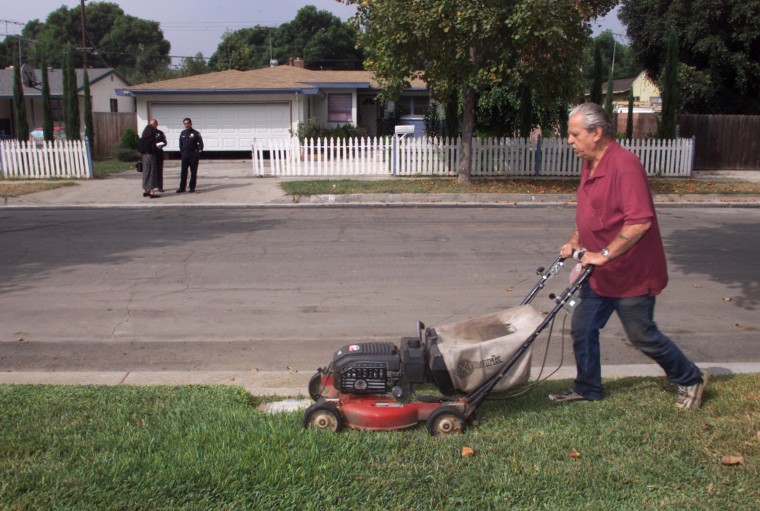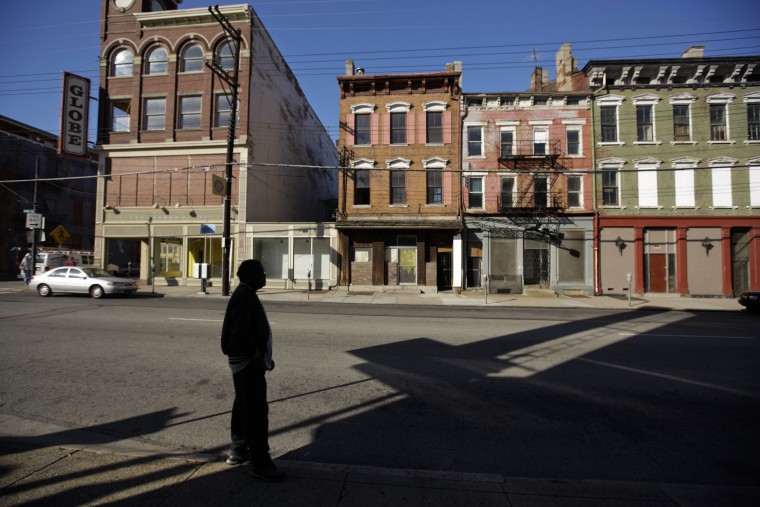When I moved into a densely populated urban neighborhood south of Louisville, Kentucky with my husband a few years ago we noticed two things right away. We experienced more crime than in the neighborhood we'd moved from. And in no time we knew a large swathe of our neighbors, versus the sole couple we knew on our old block.
In conversation with neighbors one night, a friend from the next block made a passing comment. “You have a responsibility to the neighborhood when you live somewhere like this,” she said. Unlike in the suburbs where you can come home, close your garage door, and be done with the world outside, here we all look out for each other — and we care, passionately, about what happens in our neighborhood.
And that's key to reducing crime, according to University of Michigan professor Marc A. Zimmerman, Ph.D., who wrote “Want to fight crime? Plant some flowers with your neighbor” based on his work with the University of Michigan School of Public Health Youth Violence Prevention Center.
Eager to learn how people like my neighbors and I could battle a recent spate of crime in our community, I reached out to Zimmerman for insights into his research that anyone looking to prevent crime in their neighborhood could learn from. And I spoke with Major Joshua Judah, Commander of my neighborhood's police division.
Zimmerman says busy streets = safer streets
While there's no easy answer of course, a lot of what Zimmerman had to share boiled down to one concept: creating busy streets. Why busy?
“I grew up going to New York City,” Zimmerman said. “I always want to walk on the busy street — I might get pickpocketed, but probably not beaten up or stabbed.”
He was looking for a counterpart to what the broken windows theory had become, he said, by asking: “What builds a neighborhood back up?”
Busy streets flips the logic of the broken windows theory — a controversial criminological approach to public safety — on its head, Zimmerman wrote. Broken windows defenders see urban disorder in U.S. cities — graffiti, litter, actual broken windows and the like — as a catalyst of antisocial behavior. So they direct police to crack down on minor offenses like vandalism, turnstile jumping and public drinking.
With an emphasis on looking at positive approaches like empowerment and engaging youth rather than 'fixing them,' we looked at busy streets, which is 'if we build it they will come,'” he said.
Green spaces can make a difference
“What happens if we start creating nice green spaces?” he went on. “Does greening make a difference?”
In a word? Yes. “I feel more confident in this than almost anything else I've done in my research,” he said.
Zimmerman took that research to Flint, Michigan, a city known for crime and blight long before the water crisis (and hometown for my husband's family), where he documented the process of neighborhood engagement and its results on crime.
The project involved a group of residents along with businesses and colleges called the University Avenue Corridor Coalition who tackled a three-mile stretch of central Flint with regular neighborhood cleanup days.
The coalition grew from a group of residents and stakeholders who attended a workshop on Crime Prevention Through Environmental Design, reported the local online magazine Flintside, aided by some large grants.
“What they did is say 'we're going to take control of this area,'” said Zimmerman. "[That included] gems of Flint in its heyday that had gone into disrepair and were run down. They cleaned up the median, they put lighting up, made a bike path, they extended beyond this street. Taking over an empty park, they put sidewalks in and made it more inviting.”
One big success for the group and neighborhood was replacing a corner liquor store with a sandwich shop, Zimmerman said. For anyone who lives in a place where you can walk to get groceries or food anytime, putting in a Jimmy John's may not seem like much. But this liquor store had been called a “Stab 'n’ Grab” because of the frequent fights breaking out, he said, and this was a part of town with almost nowhere to go eat. Once there was a place to go, “people started coming during the day, and at night wasn't as much of a hangout. Businesses across the street were inspired to fix up their places.”
The result of these efforts? “According to the coalition’s latest report, assaults decreased 54 percent, robberies 83 percent and burglaries 76 percent between 2013 and 2018,” Zimmerman wrote.
“It’s also meant seeing the neighborhood come alive with food trucks, bike patrols and neighborhood cleanup days — all of which have increased quality of life and safety along the avenue,” Flintside reported.
It can be as simple as the length of the grass
So can something as simple as making an unkempt neighborhood prettier reduce crime? Zimmerman has been studying just that.
He's working on a paper now that looks at three conditions: a vacant lot that's not mowed, one that's mowed by a professional, and one where a neighborhood group takes care of it with mowing or a pocket park.
“What we found was with the professional mowers over time the crime went down,” he said. But it went down even more when community members were taking care of it. (Meanwhile when the lot wasn't tended to, crime actually increased a little.)
Why does that matter? “It isn't that the grass is lower,” he said. “It's that people are paying attention and people care about the place.”
Major Joshua Judah of Louisville's police department echoed that sentiment. He spoke with me following a recent safety meeting my neighborhood called following a daylight rolling gun battle that left historic homes riddled with bullet holes.

“[In] communities that have a high level of social organization ... you have low levels of crime,” Major Judah said. And not just when it comes to group clean-up days like those our neighborhood association holds a few times a year. “Where people are hanging out on the front porch and walking to say hi to a neighbor … A predatory criminal notices when they're being watched. They go after the easiest target and don't want to be apprehended.”
“If you start taking back parts of a city,” Zimmerman said, “showing people in the neighborhood and in the city that there's somebody here paying attention and they care about the place, that is sending a message to all sorts of people.”
Showing people in the neighborhood and in the city that there's somebody here paying attention and they care about the place, that is sending a message to all sorts of people.
Marc A. Zimmerman, Ph.D.
But, wait, isn't this just gentrification?
When we're talking about neighborhood change and beautifying, “a criticism that often comes up is gentrifying,” Zimmerman said.
“There's a big debate about this and I get it,” he said. “A lot of times there are neighborhoods, typically lower income, often people of color, and it's often displacement. What we're talking about is nothing close to that.”
Working toward busy streets through clean up and beautification, “it's very community engaged,” Zimmerman said. “To me [gentrification] is when developers come in and displace people and people don't have a voice. This greening work is much more localized. It's a [vacant] lot here, an abandoned home here. It's not development per se, it's community owned and community defined and community engaged.”
Now, “if the local efforts start to change a community to make it more desirable, that could attract developers and that could create a negative situation of gentrification,” he said. “What I say to that is to make sure community voices are heard. Make sure development is respectful of the history and who lives there. There are all sorts of things you can do to bring back a community that aren't gentrification. Who wants to live in a place where families [live in fear] — I hear this in Flint, 'when I hear gunshots I send my kids into the bathroom to lay down in the tub,'” he said. “We have to do better than this.”
Start with your own front door
Making a safer place to live can start at your own front (or back) door, literally. In addition to joining forces with neighbors, residents can take steps at home, too, Major Judah said. We're talking basics, but it takes everyone doing it.
“If at night every porch light is lit up you've got a well-lit street, whether you have street lights or not,” he said. “I have a floodlight out my back door and I have a pretty bright porch light and every single night I leave them on all night (I use LED). If everybody on the block does that particularly in a true urban neighborhood, that street's lit up. It makes less shadows for people to hang out.”
Have (and use!) quality locks, Major Judah said, and camera systems are also helpful, especially “the ones where you can actually see there's a camera, and even putting a sign out that says this house has an alarm and you're being videoed.” (We ponied up for Nest cameras after I spoke with the commander.)
The idea is that the opportunity for crime isn't at your house, nor at your neighbors', he said. “Sometimes that offender becomes less motivated to commit that crime and may not [even do it at all].”
When there is a concerted crime prevention in one neighborhood you have a diffusion of benefits into other areas.
While people are often concerned about pushing crime on down to the next neighborhood, “research doesn't support that,” he said. “It supports when there is a concerted crime prevention in one neighborhood you have a diffusion of benefits into other areas.”
How so?
“Criminals operate in areas they feel comfortable and know well,” he explained. “Think of a teenage kid breaking into cars — they know the escape route, they know where police will come from. If they can't operate there they have to be really motivated to go to another neighborhood where they don't have that information. Oftentimes they will do something else — or nothing.”
Doing nothing may be an option for them. But like my neighbor said, living in an urban community comes with responsibilities. Doing nothing isn't an option for us.
MORE FROM BETTER
- How to be a better reader
- How to improve your memory, according to neuroscience
- Why our sense of time speeds up as we age — and how to slow it down
- How to train your brain to accept change
- You can train yourself to be more patient. Here's how.
Want more tips like these? NBC News BETTER is obsessed with finding easier, healthier and smarter ways to live. Sign up for our newsletter and follow us on Facebook, Twitter and Instagram.


